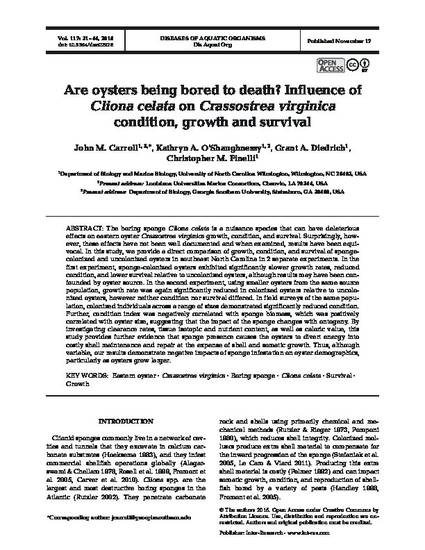
The boring sponge Cliona celata is a nuisance species that can have deleterious effects on eastern oyster Crassostrea virginica growth, condition, and survival. Surprisingly, however, these effects have not been well documented and when examined, results have been equi-vocal. In this study, we provide a direct comparison of growth, condition, and survival of sponge-colonized and uncolonized oysters in southeast North Carolina in 2 separate experiments. In the first experiment, sponge-colonized oysters exhibited significantly slower growth rates, reduced condition, and lower survival relative to uncolonized oysters, although results may have been confounded by oyster source. In the second experiment, using smaller oysters from the same source population, growth rate was again significantly reduced in colonized oysters relative to uncolonized oysters, however neither condition nor survival differed. In field surveys of the same population, colonized individuals across a range of sizes demonstrated significantly reduced condition. Further, condition index was negatively correlated with sponge biomass, which was positively correlated with oyster size, suggesting that the impact of the sponge changes with ontogeny. By investigating clearance rates, tissue isotopic and nutrient content, as well as caloric value, this study provides further evidence that sponge presence causes the oysters to divert energy into costly shell maintenance and repair at the expense of shell and somatic growth. Thus, although variable, our results demonstrate negative impacts of sponge infestation on oyster demographics, particularly as oysters grow larger.
Available at: http://works.bepress.com/john-m-carroll/4/

© 2015 The Authors. Open Access under Creative Commons BY-Attribution License. Use, distribution and reproduction are unrestricted. Authors and original publication must be credited.
This article was retrieved from Disease of Aquatic Organisms.